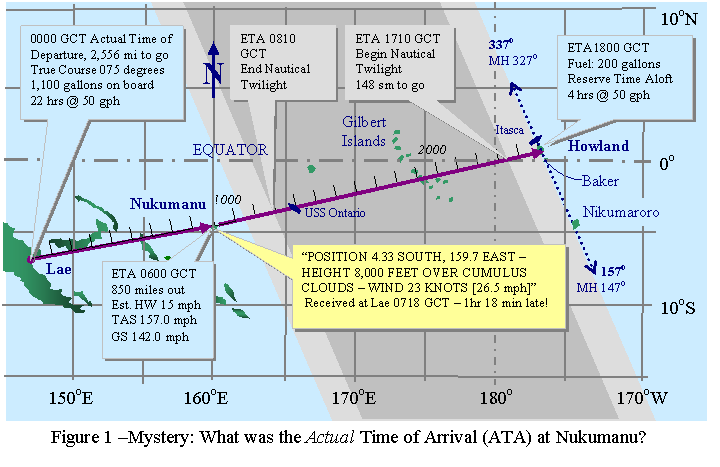|
Copyright ©2010 by Paul Niquette. All rights reserved. |
||||||||||||||||||||||||||||||||||||||||||||||||||||||||||||||||||||||||||||||||||||||||||||
 Reprised
below is Figure 1 from The Clock
Won’t Wait puzzle,
Fred Noonan’s plan for the Lae-to-Howland flight.
Shown is an estimated
time enroute (ETE) of
6.0
hours for the 850 miles from Lae to the waypoint
overhead Nukumanu Island.
Noonan's estimated time of arrival (ETA)
of 0600 GCT is indicated on the chart. Continuing
under those speed
conditions for the 1,706 miles from Nukumanu to Howland
Island would result
in an ETE of 12.0 more hours and a total time aloft of
18.0 hours for an
ETA of 1800 GCT at Howland. Reprised
below is Figure 1 from The Clock
Won’t Wait puzzle,
Fred Noonan’s plan for the Lae-to-Howland flight.
Shown is an estimated
time enroute (ETE) of
6.0
hours for the 850 miles from Lae to the waypoint
overhead Nukumanu Island.
Noonan's estimated time of arrival (ETA)
of 0600 GCT is indicated on the chart. Continuing
under those speed
conditions for the 1,706 miles from Nukumanu to Howland
Island would result
in an ETE of 12.0 more hours and a total time aloft of
18.0 hours for an
ETA of 1800 GCT at Howland.
Meanwhile as noted in the planning chart, Noonan’s estimated fuel consumption rate at 157.0 mph was 50 gph. With 1,100 gallons onboard the Electra at takeoff, the plane could stay aloft for up to 22.0 hours, affording 4.0 hours of fuel in reserve on arrival. 
Noonan's flight plan is summarized as Case 0 in the table below, wherein the headwind forecast of 15.0 mph subtracted from the planned airspeed of 157.0 mph would enable the Electra to 'make good' a groundspeed of 142.0 mph. The actual time of arrival (ATA) at Nukumanu in Case 1 is based on the time at which Earhart’s position report over Nukumanu was logged at a radio station in Lae, specifically 0718 GCT -- more than an hour-and-a-quarter behind schedule.
Now, an ATA at Nukumanu of 0718 GCT also means a reduced airspeed of 14.1 mph (9%) to 142.9 mph in Case 1. Some but not all of the reduction of airspeed over that flight segment would have resulted from the 8,000-ft climb for the heavily loaded aircraft between Lae and Nukumanu. However, once at altitude, the higher airspeed would be the common practice at the beginning of a long flight, gradually slowing as the plane burns off extra weight (see Wages of Flight). Taken together, these factors make an ATA of 0718 GCT at Nukumanu a doubtful proposition. The table above shows that holding the same throttle settings all the way to Howland Island would lengthen the time aloft 22% to 22 hours; however, the fuel savings from flying slower would be at least 9%, assuring a reserve of about 2.2 hours on arrival.  Case
2 ATA at Nukumanu results from simply splitting
the ETEs between Case
0 and Case 1 for a compromise of 0642 GCT
(36 minutes before
Amelia Earhart completed her position
report). By pure happenstance
the ETA of 2013 GCT at Howland in Case 2 is
almost exactly the time
of the last radio transmission from the Electra (see Which
Way, Amelia?). Case
2 ATA at Nukumanu results from simply splitting
the ETEs between Case
0 and Case 1 for a compromise of 0642 GCT
(36 minutes before
Amelia Earhart completed her position
report). By pure happenstance
the ETA of 2013 GCT at Howland in Case 2 is
almost exactly the time
of the last radio transmission from the Electra (see Which
Way, Amelia?).
With an airspeed of 153 mph in Case 2, fuel consumption rate would be reduced slightly (perhaps 3%), affording a reserve on arrival of about 2.5 hours.Case 3 uses the flight-plan airspeed, 157.0 mph, from Case 0 along with the corresponding fuel consumption rate, 50 gph, but penalizing groundspeed by the measured headwind of 26.5 mph. The ETE, then, would be 6.5 hours for an ATA at Nukumanu of 0630 GCT (some 42 minutes before Amelia Earhart completed her position report). In Case 3, maintaining 157.0 mph for the rest of the flight results in an ETA at Howland of 1936 GCT, which affords 2.4 hours of time aloft in reserve.Case 4 achieves the same ATA at Nukumanu as Fred Noonan's flight plan in Case 0, overcoming the measured headwind of 26.5 mph by flying faster. The requisite airspeed is 168.2 mph, an increase of 7% over the 157.0 mph in Case 0. That would call for an increase in fuel consumption of at least that much (see Wages of Flight) to 53.5 gph. Even at 168.2 mph, the ETA at Howland (1800 GCT) in Case 4 would nevertheless afford 2.5 hours of time aloft in reserve on arrival.Solvers of Here Comes the Sun will know why Fred Noonan would have called for that extra speed -- or most likely higher -- and why he would willingly suffered the impact in fuel consumption all the way to Howland. There was a critical reason to fly fast. Earhart and Noonan were in a race against time. By the above reasoning, it should be clear that the solution to The Clock Won’t Wait puzzle is indeed...
|